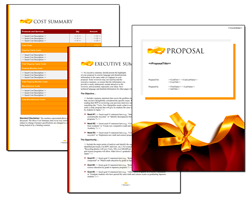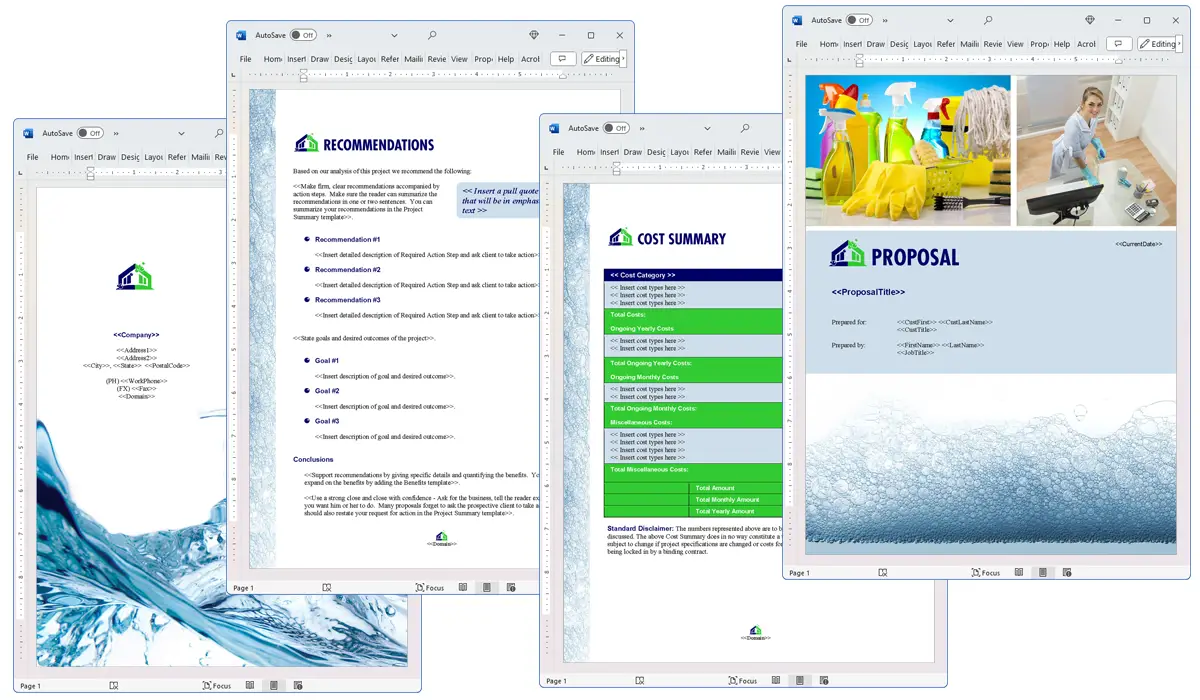What is the Microfinancing chapter used for?
Proposal Kit Professional Bundle adds more design themes, all six Contract Packs,
a project management library, and Expert Edition software.

Illustration of Proposal Pack Tech #9
We include this Microfinancing chapter template in every Proposal Pack, along with thousands more. You assemble this chapter with others in various combinations to create custom-tailored business proposals, plans, reports, and other documents. Proposal Packs apply custom visual designs to the templates, giving the final documents a consistent professional finish.
 DOWNLOADABLE, ONE-TIME COST, NO SUBSCRIPTION FEES
DOWNLOADABLE, ONE-TIME COST, NO SUBSCRIPTION FEES
Overview of the Microfinancing Chapter
The Microfinancing chapter is a specific section in the Proposal Kit system designed to help users articulate and present their plans for setting up microfinancing services. Microfinancing is an important financial service that provides small loans to startups, individuals, and small businesses in underdeveloped areas, which often lack access to traditional banking services. This chapter helps proposal writers communicate the need and plan for offering these micro loans, which are important for enabling economic growth and entrepreneurship in these regions.
How is the Microfinancing Chapter Used?
In a business proposal, the Microfinancing chapter serves as a dedicated space where the proposal writer can detail their ideas for initiating or supporting microfinancing activities. This section is used to outline the objectives, target audience, and benefits of providing microfinancing. It also includes details on the operational aspects of the program, such as funding sources, loan distribution methods, and interest rates. The inclusion of this chapter is particularly important when the proposal's aim is to secure funding or partnership from stakeholders interested in developmental projects or financial inclusion initiatives.
What is Included in the Microfinancing Chapter?
Typically, the Microfinancing chapter includes several key elements:
- Introduction to Microfinancing: A brief on what microfinancing is and its importance in the specific context of the proposal.
- Objectives: Clear objectives of the microfinancing program being proposed.
- Target Beneficiaries: Detailed information about who will benefit from the micro loans, such as small business owners or individuals in specific regions.
- Program Details: How the microfinancing will be structured, sources of funding, loan repayment terms and conditions, and any financial management strategies to be employed.
- Expected Outcomes: The anticipated impact and benefits of the microfinancing program, which could include economic upliftment, increased entrepreneurial activities, or improved financial inclusion.
Use Case Examples for the Microfinancing Chapter
- Finance: A proposal for a microfinance institution outlining different loan products and services tailored for small-scale entrepreneurs.
- Insurance: Part of a business plan for an insurance company looking to offer micro-insurance products alongside micro loans.
- Legal: Used in proposals by legal firms aiming to provide affordable legal services to small businesses financed through micro loans.
- International: Included in proposals for international development projects focusing on economic development through microfinancing in underdeveloped countries.
- Business Plans: As a section in business plans for companies that intend to include microfinancing as part of their business offerings.
- Business Opportunities: In proposals seeking investors or partners in ventures providing microfinancing solutions.
- Franchise: For franchise businesses looking to establish microfinancing funds to help expand their network of franchisees.
- Vending: Proposals for vending machine businesses that plan to use microfinancing to help small vendors get started.
- Obligations: Detailed in legal and financial obligation documents to clarify the terms and conditions associated with the microfinancing provided.
Key Takeaways
- The Microfinancing chapter is important for proposals focused on establishing or supporting microfinancing initiatives.
- It helps clearly communicate the purpose, strategy, and operational details of proposed microfinancing programs.
- This chapter is and can be adapted for use in various industries including finance, insurance, and international development.
- Key components of the chapter include objectives, target beneficiaries, program details, and expected outcomes.
- Effective use of the Microfinancing chapter can enhance the chances of securing funding or partnerships necessary for project success.

Illustration of Proposal Pack Elegant #7
 What Our Clients Say
What Our Clients SayAdding information, click to next section, then add more information to then see the final layout in WORD is amazing. No need to worry about formatting, so I just pick what information I want for the proposal, report, or contract, and ensure what I want to say makes sense--the fixings are there and I just add the meat & potatoes."
Global Health Science Institute
 4.7 stars, based on 845 reviews
4.7 stars, based on 845 reviewsAlternate Chapters
Related Chapters
Document Layouts Using the Microfinancing Chapter

The Microfinancing chapter and other chapters are integrated into a Word document as illustrated here in the Proposal Pack Janitorial #3 design theme. There are hundreds of design themes available, and every design theme includes the Microfinancing chapter template.
A proper business proposal will include multiple chapters. This chapter is just one of many you can build into your proposal. We include the complete fill-in-the-blank template in our Proposal Pack template collections. We also include a library of sample proposals illustrating how companies in different industries, both large and small, have written proposals using our Proposal Packs. This template will show you how to write the Microfinancing.
We include a chapter library for you to build from based on your needs. All proposals are different and have different needs and goals. Pick the chapters from our collection and organize them as needed for your proposal.
Using the Proposal Pack template library, you can create any business proposal, report, study, plan, or document.
 Ian Lauder has been helping businesses write their proposals and contracts for two decades. Ian is the owner and founder of Proposal Kit, one of the original sources of business proposal and contract software products started in 1997.
Ian Lauder has been helping businesses write their proposals and contracts for two decades. Ian is the owner and founder of Proposal Kit, one of the original sources of business proposal and contract software products started in 1997.By Ian Lauder
 Published by Proposal Kit, Inc.
Published by Proposal Kit, Inc.


 Cart
Cart
 Facebook
Facebook YouTube
YouTube X
X Search Site
Search Site